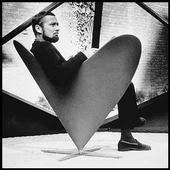Over the course of his career Verner Panton (1926-1998) introduced a series of modern chairs, environments and lighting with personalities unlike those of any of his Scandinavian contemporaries. With a remarkable faith in the unlimited possibilities of traditional forms, he worked successfully to create a new set of theories about how a chair should look and how it should seat someone as well as how vibrant colors could find their way into corporate and residential environments. Experimenting with every material available, and spurned on by the rapidly advancing technology of the production processes, he created a body of work that is astounding for its elegance and for the remarkable diversity of his pieces.
He was trained at a technical school in Odense as an architectural engineer and then at the Royal Danish Academy of Fine Arts in Copenhagen. He worked in Arne Jacobsen's architectural office from 1950-52, where it is rumored that he was one of the worst workers, ostensibly because he was preoccupied with his own designs. Panton made contacts with manufacturers by travelling through Europe in a Volkswagen bus outfitted as a drafting studio. He started his own design office in 1955 and, in the same year, came out with the tubular steel, canvas and woven plastic "Bachelor" and "Tivoli" chairs. In 1958 his work as the architect of the Applied Art display at the Fredericia Furniture Fair was a harbinger of his non-traditional approach to the tenets of design. Shocking both attendees and artists, he displayed the furniture by hanging it from the ceiling of the stand. With his 1958 "Cone" chair, and the "Heart" chair the following year, both made of upholstered bent sheet metal, he began to subtly change the structure of the chair. The chairs had no discernible back, and no legs, and resembled a sculpted cylinder into which someone would be inserted. Because his chairs, even from the beginning, rarely had traditional legs, critics at the time suggested that they should be called ‘seats’ rather than try to imagine them as chairs.
The 1960s stacking "Panton" chair, has since become his most recognizable design and is still in production using different plastics. This chair, the first to be produced from a single piece of molded plastic, brought Panton international recognition with its modern and unexpected form. It debuted on the cover of Mobilia in August 1967 and was awarded an A.I.D. award in 1968. The shape of the chair, a single curve with no extraneous skeleton was designed to give a soft, rather than rigid, support and it was made is a range of bright colors. Originally produced by Fritz Hansen, it was later picked up and put into mass production by Herman Miller and later Vitra.
In the late 1960s and early 1970s Panton experimented with a radical series of upholstered environments. He wanted "to encourage people to use their fantasy and make their surroundings more exciting," and to this end created the 1963 "Flying" chair, the 1963 "Upholstered Seating System," the 1968 "Pantower," an upholstered unit with several levels, and the 1974 upholstered "Sitting Wheel." This series of designs was inspired by Panton's philosophy that a set of furniture should interact within itself as "a kind of chair landscape, which refuses to be just functional." Two chairs he created for Cassina in 1979, "Sisters Emmenthaler" and the "Mrs. Emmenthaler" chaise longue, were more playful and figurative, imitating the shape of the body.
Panton’s other great contribution to mid-century design is his ceaseless experimentation with lighting. His "Fun" series of shell lamps, his hanging "Globe" lamp and a wide variety of chandeliers introduced a new approach to lighting. He designed entire walls filled with lit panels and futuristic UFO shaped hanging lights. Panton’s designs were made to sway, spiral, create sounds and, most of all, to use color to create completely unique lighting systems for interiors.
The interiors, furniture, lighting and objects designed by Verner Panton remain among some of the most forward thinking experiments in design. His prescient knowledge of the movements that would become Pop, and later Postmodern Design, can be seen in some of his earliest work and an understanding of the remarkable influence that he exerted over designers and artists since 1960 is only just now being explored. As the thousands of drawings in his archives come forward, we can only imagine that these pieces will continue to serve as a blueprint for many aspects of the future of design.
This profile was edited with mywickedspace.com Editor
